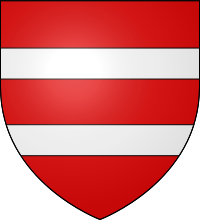- Château d'Ochsenstein
-
Château d’Ochsenstein (Ochsenstein Castle) Basse-Alsace, Alsace, France. Bas-Rhin (Lower Rhine), Reinhardsmunster fr:Fichier:France relief location map.jpg Type Château-fort Coordinates 48°40′58″N 7°17′59″E / 48.6828°N 7.2998°ECoordinates: 48°40′58″N 7°17′59″E / 48.6828°N 7.2998°E Built started in the 13th Century, ended in the 16th Century Current
conditionClassified as an Historical Monument (1898) Ochsenstein Castle (Le château d'Ochsenstein) is a ruined fort located in the French commune Reinhardsmunster, in the Bas-Rhin department (one of the 96 administrative divisions of France, excluding its overseas terrtories). It was home to the Ochsenstein, a powerful family from Medieval Alsace. The castle sits upon three sandstone spurs and comprises three separate castles: le Grand Ochsenstein, le Petit Ochsenstein and a third building, thought to be called le château de Wachelheim.
Ochsenstein castle has been classified as an historical monument since 1898.
Contents
Geographical location
Position
Ochsenstein Castle is located in the heart of the Saverne State Forest and occupies the southern end of the Schlossberg mountain, at a height of 584 metres. The ruins tower above the glade and the Haberacker Forest House (altitude: 476 metres). The site is surrounded by steep slopes, except to the north of the Schlossberg summit plateau where the terrain is flat. The castle overlooks an old strategic passageway, which rises from the Alsace plain and Reinhardsmunster through the Mosselthal vallley, to reach the Baerenbach valley, the Stambach,Annex and, which finally reaches Lutzelbourg, and Phalsbourg in Lorraine.
Access
From Saverne, take the D171, then take the forest road which passes le Schaeferplatz. Follow this until you reach the Haberacker farms. Park your car near the farms and take the forest path marked by a blue rectangle (GR 531).The castle is about 20 minutes from the farms, roughly 110 metres above.
Local Area
The castle ruins are located:
- 7 km South-West of the Saverne
- 1,5 km West / North-West of Reinhardsmunster
- 5 km West of Marmoutier
- 6 km North East of Dabo in Moselle
- 500 m above the isolated farms of Haberacker
- 1 km North-West of the "Billebaum" crossroads
History
Template:Article détaillé
The Ascension of the Ochsensteins
The Construction and Orgins of the House of Ochsenstein
Ochsenstein Castle is thought to have been built in the late 12th Century. It is part of a chain of Vosges castles near Saverne which were built to defend the passage from Alsace plain to Lorraine. The Lordship of Ochsenstein was carved out of the lands of the Marmoutier Abbey by the diocese of Metz.
The first mention of a Lord of Ochsenstein dates back to 1187: Bourcard Ochsenstein signed a charter by Frédéric Barberousse confirming his possessions[1] to the Koenigsbrück Abbey. Therefore, the castle must have already been in existence then as the custom at the time was that descendants use their surname as the name of the castle.
The Succcession of Otto 1st
When he became ill in 1217, Otto 1st shared his land among his sons. Two of them entered the clergy and the other three inherited the castles. Otto 2nd, the eldest, received Ochsenstein Castle - known then as ‘der Fels’ (the rock) - the service of the knights who guarded it (the Burgmänner) the mountain on which it is built and farms nearby. The second son, Eberhard, received Wachelheim Castle: this castle was probably the one that was built on the third stone spur.[2] Conrad, the third son, received the Greifenstein Castle but had to recognise the usufruct to the nobles who occupied it. Otto 1st survived his illness and lived until 1241. At that point, his children inherited his legacy according to the plans he laid out in 1217.
Alliance with the Habsbourgs
Otto 3rd,[3] the son of Otto 2nd married Cunégonde of Habsbourg. She was the sister of Rudolph of Habsburg who was elected King of the Romans in 1273. The Ochsenstein home thus gained great influence and the castle became the centre of a large Lordship that included Marlenheim and Barr (1321).
Otto 4th,[3] son of Otto 3rd, remained loyal to Rodolphe of Habsburg, accompanying him in his military campaigns. As a reward for this loyalty, Rodolphe appointed him landvogt of Alsace and Breisgau (a provincial bailiff). Otto 4th’s zeal and his growing influence caused him to make many enemies, including the bishop Conrad of Lichtenberg and Guillaume 3rd of Hohenstein.
The Destruction of the Petit Ochsenstein
In 1284, Guillaume of Hohenstein captured Eckerich Castle from Duke Frédéric of Lorraine. Otto 4th tried to restore the castle to the Duke. In his absence, Guillaume of Hohenstein and the bishop of Strasbourg attacked Ochsenstein Castle. The Burgmänner who defended it were hunted and the castle was destroyed (most likely burned). It is probably the Petit Ochsenstein which was destroyed but was then quickly rebuilt by Otto 6th.[4]
The Decline of the Ochsensteins and the Castle’s Importance
The Progressive Estrangement of the Castle
The Lords of Ochsenstein did not always reside in their castles: Otto 4th resided mostly in Haguenau Palace, the residence of the Landvogt. Otto 5th,[3] referred to as Landvogt of Alsace and Speyergau when the Habsbourgs returned to power, resided in Landau.
The Ochsensteins owned another residence in Strasbourg since 1259. It stood in the current Rue Brulée (Burnt Street), which was named after Ochsensteinergasse and occupied part of the current Town Hall site. The Burgmänner who had guarded the Ochsenstein Castle no longer lived there. The castle was used by the Ochsensteins as collateral for cash advances (around 1400, Otto 7th hired out his castles for a thousand florins).
Another Destruction of the Petit Ochsenstein
The Ochsenstein decline began in the late Template:14th Century. Rudolph 2nd lead many conflicts including the one which caused the city of Strasbourg to besiege the castle in 1382. Once conquered, a small garrison was added, but then the castle staff was cut as their maintenance was deemed too expensive. Trendel, like Lehmann, assume this happened in the Petit Ochsenstein castle.[5]
Whichever it was, the castle was rebuilt when, in 1403, Frédéric of Ochsenstein signed an agreement with his brothers on the sharing of the Ochsenstein castles’ maintenance costs. It mentions that they should contribute to the expenses concerning "the three castles" if they wanted to come and live there.[6]
The Sharing of the Castle
Like his father, Frédéric was involved in many conflicts. Notably, one was with the Margrave of Baden; Frédéric was obliged to give him half of the Ochsenstein Castle in 1411 after an arbitration which was conducted by his stepfather Hanemann 2nd of Deux-Ponts-Bitche. One clause provided for the return of the entire castle to Frédéric in case of the Margrave’s death. However, Frédéric died first, in October 17th 1411, without leaving an heir. His brother, Volmar, inherited the castle and left his orders to start a family. This did not affect the tensions between the Ochsensteins and the Margrave of Baden. Hence, Volmar was forced to give up half of Ochsenstein Castle on November 11th 1411. Volmar tried to fight against its influence by giving Louis 4th of Lichtenberg the right to his castle, but he also had to give this right to the Margrave and his sons in 1417. In addition, to help his brother, Jean, to become provost of the general chapter of Strasbourg, Volmar yielded to the bishop of Strasbourg, Guillaume 2nd of Diest, giving him half of the castle.
The post-Ochsenstein period and Demolition
The Legacy is Passed to the Deux-Ponts-Bitches
Georges of Ochsnstein, who succeeded his father, Volmar, in 1426, also came into many conflicts. The ransoms he had to collect when he was captured contributed to the ruin of his home. In 1485 after he died, it was his sister Cunegonde, the wife of Henry 1st of Deux-Ponts-Bitche, who inherited the estate. Guillaume de Ribeaupierre attempted to challenge this legacy by arguing that the Ochsenstein legacy is "masculine" and cannot fall to a woman. Henry obtained the backing of the bishop of Metz for just three years (1487 -1490), before the bishop retracted it.[7]
Successive Re-purchasing and Reconstruction
Economic problems lead George de Deux-Ponts-Bitche to mortgage the castle with Ulric of Rathsamhausen-zum-Stein for a value of 2800 florins. The castle was then passed to Sébastien of Landsberg who had received a dowry from his wife, Anne of Rathsamhausen; the couple settled in the castle in 1527 although it is described as being dilapidated.
In 1555, Jacques de Deux-Ponts-Bitche redeemed the Landsberg’s mortgage. Receiving the subjects of the lordship of Ochsenstein oath of allegiance four years later, he launched the renovation work (it is likely that the castle was adapted to accommodate firearms at this time). However, in 1559, whilst he was preparing to live there, a fire consumed the castle, reducing it to ruins.
Demolition
The Count Philippe 5th of Hanau-Lichtenberg inherited the ruined castle after Jacques’ death in 1570; the Linange-Wesburg family protested and it was only in 1691 that a compromise was reached. In the Template:18th Century, the castle’s stones were used to build a hunting lodge near the Haberacker farm; it has since been in a state of collapse.
Architecture
Map of the Grand Ochsenstein
Parts that are still visible:
- The ruins of the polygonal room, the polygonal chapel, the lower court and the semicircular firearms tower at the Grand-Ochsenstein
- Some relics of the fortifications at the Petit-Ochsenstein
Also See
Connected Articles
- Ochsenstein
- Geroldseck
- Haut-Barr
- Abbaye de Marmoutier (Marmoutier Abbey)
- Liste des châteaux d'Alsace (Liste of Alsace castles)
Bibliography
- Les Châteaux des Vosges, Les Châteaux autour de Saverne. Christophe Carmona et Guy Trendel, Editions Pierron
- Nouveau Dictionnaire de Biographie Alsacienne. Fédération des Sociétés d'Histoire et d'Archéologie d'Alsace, volume 28, pages 2889 à 2893
Notes
- ^ Les Châteaux autour de Saverne, p.51
- ^ Les Châteaux autour de Saverne, p.52
- ^ a b c La numérotation des seigneurs d'Ochsenstein utilisée dans cet article est celle du Nouveau Dictionnaire de Biographie Alsacienne. Carmona et Trendel, dans leur ouvrage Les Châteaux des Vosges, Les Châteaux autour de Saverne, utilisent celle plus ancienne de Dagobert Fischer Ochsenstein, le château et la seigneurie, 1878 et d'Edouard Sitzmann Dictionnaire de biographie des hommes célèbres de l'Alsace, 1910 qui omet Otton II ce qui décale leur numérotation en conséquence.
- ^ Les Châteaux autour de Saverne, p.53
- ^ Les Châteaux autour de Saverne, p.56
- ^ Les Châteaux autour de Saverne, p.58
- ^ Les Châteaux autour de Saverne, p.61
External links
Categories:- Châteaux in Bas-Rhin
- 13th-century architecture
- French castle stubs
Wikimedia Foundation. 2010.



